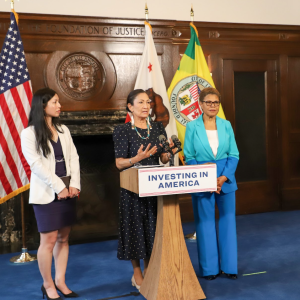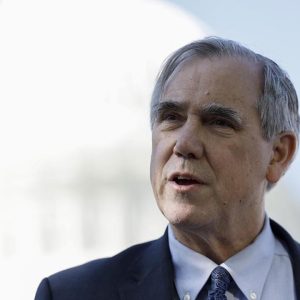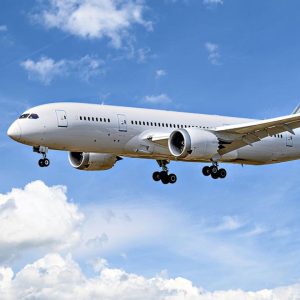 View Winners →
View Winners → Forest Service, County Planning Dept. Warns Bungee Business of Violations
Zoning Change Could Allow Operation to Continue
By Joe Taglieri
Officials have warned a long-standing bungee jumping business in the Angeles National Forest that it is violating county zoning regulations. However, recent zoning code revisions could allow it to continue, much to the chagrin of U.S. Forest Service volunteers who work in the area.
Despite for the last two decades regularly conducting weekend hiking excursions to and from the Bridge to Nowhere, located about 25 miles northeast of Azusa near the east fork of the San Gabriel River, Bungee America received word from the Los Angeles County Department of Regional Planning to stop conducting bungee jumps and zip-line runs and remove two of its three 40-foot metal storage containers.
The containers house bungee gear, tools, and camping equipment for the company’s overnight weekend staff, according to an Oct. 28 letter from a Bungee America attorney to the planning department. One container serves as a hangar for the company helicopter, which utilizes a helipad on the property.
The bridge is on a 50-acre parcel in the San Gabriel Mountains owned by Bungee America CEO Ron Jones and borders the federally owned Angeles National Forest.
The planning department’s violation notices went out nearly a year ago, but so far it’s been business as usual for Bungee America. The department granted the company’s requests to continue operating as the county Board of Supervisors considers a zoning code change that would allow for-profit recreational activities in the area currently zoned for light agricultural use.
The Forest Service, however, nixed the zip line because its termination point crossed the boundary between Jones’ property and federal land.
After receiving the violation notices Bungee America lobbied planning officials and representatives of Supervisor Michael Antonovich’s office for a zoning code change, which the board unanimously approved in November as part of a comprehensive update to the regional planning policy in the supervisor’s district.
The Bridge to Nowhere is part of the Antelope Valley Area Plan, which stretches from the San Bernardino County line to the Santa Clarita Valley and applies to the northern, mostly rural areas of the county.
Antonovich staff members did not respond to requests for comment.
The board must again vote to confirm its approval of the plan update before the Bridge to Nowhere zoning change takes effect, said Supervising Regional Planner Oscar Gomez, who issued the violation notices. Planning staff is waiting for the zone change to take effect before deciding whether or not to allow Bungee America to subsequently continue operating in the area.
The new zoning regulation, which Gomez guessed would be up for a confirming board vote in May, requires Bungee America to file for a conditional use permit in order to continue using the bridge on a weekly basis. This is a somewhat lengthy permitting process that includes an environmental impact assessment by planning staff and a public hearing.
“Our department is right now reviewing that request to continue operating while they file this CUP,” Gomez said.
“The department will see if they meet all the [criteria] and if it’s granted, then they file their CUP and there’s a hearing,” he explained. “The CUP requires a public hearing and neighbors have a chance to attend the hearing and express their views. The worst case is there’s many unanswered issues, concerns, and the department decides not to grant the waiver at which time they’d have to stop and … they could no longer operate. … The zone change does not make any notice of violation moot.”
The planning department first became aware of the violations after Forest Service volunteers alerted the agency’s ranger staff of concerns they had about Bungee America’s large groups of customers, which they estimated at times exceed 50 people. It’s a 10-mile round-trip hike from the trail head that starts at a parking lot at the end of Camp Bonita Road to the bridge, and trail workers object to issues that include public safety concerns, parking availability and inadequate permitting.
“[Jones] should have never been allowed to get as far as he’s gotten with the zone change,” said Ben White, head of the San Gabriel Mountains Trailbuilders. “He knew what he was buying when he bought it, he knew what was allowed and not allowed, yet he set up this business.”
Jones contended that his business “was licensed by the state over 20 years ago. It was our understanding that we met all the requirements.”
Tom Walsh leads the Fisheries Resource Volunteer Corps and regularly patrols the San Gabriel River’s east fork area, performing a wide range of trail, wilderness, and river maintenance that includes lending a hand in the realm of public safety.
Walsh opposes the zoning change largely because Bungee America customers and staff have to cross federal land to get to the Bridge to Nowhere on Jones’ property, which he said puts an undue strain on the area’s natural environment as well as on the limited resources of the Forest Service and affiliated volunteer groups such as the FRVC.
“We have on many, many occasions had to get [Bungee America’s] customers out of trouble who weren’t capable of making the hike,” said Walsh, who has volunteered in the area since 1999.
“They don’t care because they’ve got [customers’] money up front,” he added. “So if only 10 people show up out of 50 because something happened to them or they got lost along the way — we’re constantly giving their customers directions because they’re lost.”
Jones countered: “The bungee operation has a vested interest keeping the entire five-mile hike of this canyon in a beautiful condition. … There are groups who clean the trail once or twice per year and we thank them for their contribution, but we do more to clean it every year than any other group because we are there every weekend.”
Jones also touted his company’s public safety record: “Every year we assist the general public by rendering assistance in the form of providing them first aid and EMS. … With our satellite phone capabilities we are the only emergency communication to the outside world and on 8-10 occasions per year the public asks for our assistance.”
In 2010, however, a Bungee America instructor, 24-year-old Mykel Sargent, was reportedly found dead in a ravine below the bridge after fellow campers reported him missing early on a Sunday morning.
Jones denied he fell from the bridge and declined to comment further.
Walsh and White also noted weekend parking scarcity that they attributed to Bungee America.
“Parking is very limited, and you’ve got 60 to 100 people going on a weekend day and taking up all of this parking area crowding everybody else out, everybody that’s just going to do hiking or enjoy the area for reasons other than bungee jumping,” White said.
“[Jones] should be required to transport those people in there somehow in a bus that he operates and not dominate that parking lot for everyone else that goes in there,” Walsh said.
“Bungee America customers and staff do not dominate the parking at the trailhead,” Jones said. “In fact, we utilize less than 25 percent of the spaces.”
Walsh also claimed Bungee America operates without Forest Service permits required for hiking groups.
“First of all, to go into a wilderness area, I don’t care if you’re an individual or if you’re a group, you need to have a wilderness permit,” Walsh said. “Anybody can get one, but you’re limited to the number of people you can take into a wilderness area in one party. This operation takes in anywhere from 40 to 60 or 70 people at a time.”
According to White, Bungee America “doesn’t have an outfitter and guide permit from the Forest Service [or] a wilderness permit to conduct people through two and a half miles of wilderness through that property, and that’s a big thing as far as the abuse of the land goes. There are supposed to be small parties, they’re supposed to be guided through. [Jones] doesn’t do that.”
Forrest Service officials did not return calls for comment.
According to Jones, case law shows his company is not required to have the permits.
“We are very confident the law is clearly on our side,” he said.
“There will always be a small group of haters out there, but the public will look at our past and all the good we do for them,” Jones observed. “The public is smart and they realize the way to keep the canyon clean and preserve public access to the Bridge to Nowhere is support our cause.”
Bungee America’s website shows that jumping fees range from $99 for a single leap and $50 for each additional jump to bundled deals such as a nighttime five-jump deal for $275 and a $1,000 midweek jump package.














































































































